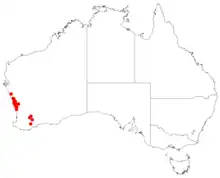| Leucopogon leptanthus | |
|---|---|
| Scientific classification | |
| Kingdom: | Plantae |
| Clade: | Tracheophytes |
| Clade: | Angiosperms |
| Clade: | Eudicots |
| Clade: | Asterids |
| Order: | Ericales |
| Family: | Ericaceae |
| Genus: | Leucopogon |
| Species: | L. leptanthus |
| Binomial name | |
| Leucopogon leptanthus | |
 | |
| Occurrence data from AVH | |
| Synonyms[1] | |
|
Styphelia leptantha (Benth.) F.Muell. | |
Leucopogon leptantha is a species of flowering plant in the heath family Ericaceae and is endemic to the south-west of Western Australia. It is an erect, bushy shrub that typically grows to a height of about 30 cm (12 in). Its leaves are erect, oblong or egg-shaped and 4–6 mm (0.16–0.24 in) long with a small, hard point on the tip. The flowers are arranged singly or in pairs in leaf axils with small bracts and bracteoles less than half as long as the sepals. The sepals are about 1.6 mm (0.063 in) long, the petals joined at the base to form a tube about 4 mm (0.16 in) long with lobes about 2 mm (0.079 in) long.[2][3]
The species was first formally described in 1868 by George Bentham in Flora Australiensis from specimens collected by James Drummond between the Moore and Murchison Rivers.[2][4] The specific epithet (leptanthus) means "slender-flowered".[5]
Leucopogon leptanthus occurs in the Geraldton Sandplains and Swan Coastal Plain bioregions of south-western Western Australia and is listed as "not threatened" by the Government of Western Australia Department of Biodiversity, Conservation and Attractions.[3]
References
- 1 2 "Leucopogon leptanthus". Australian Plant Census. Retrieved 16 January 2023.
- 1 2 Bentham, George; von Mueller, Ferdinand (1868). Flora Australiensis. Vol. 4. London: Lovell Reeve & Co. p. 225. Retrieved 16 January 2023.
- 1 2 "Leucopogon leptantha". FloraBase. Western Australian Government Department of Biodiversity, Conservation and Attractions.
- ↑ "Leucopogon leptanthus". APNI. Retrieved 16 January 2023.
- ↑ Sharr, Francis Aubi; George, Alex (2019). Western Australian Plant Names and Their Meanings (3rd ed.). Kardinya, WA: Four Gables Press. p. 238. ISBN 9780958034180.